Wainwright I (Destroyer No. 62)
1916-1934
Wainwright (Destroyer No. 62) was named for Cmdr. Jonathan Mayhew Wainwright, his son, Master Jonathan Mayhew Wainwright, Jr., and his cousin, Cmdr. Richard Wainwright.
Cmdr. Jonathan Mayhew Wainwright II was born in New York City on 27 July 1821 and was initially commissioned in the United States Navy on 30 June 1837. He was the son of the Episcopal bishop of New York, Jonathan Mayhew Wainwright and his wife Amelia Maria (nee Phelps). He entered the Navy as a midshipman at age 16 on 30 June 1837. He received orders to the Naval School at Philadelphia, Pa. in 1842 and became a passed midshipman a year later. He married Maria Byrd Page on 8 February 1844 and had four children. He was appointed acting master in 1849 and in September 1850, commissioned a lieutenant. With the outbreak of the Civil War, Wainwright was engaged in special duty in Washington, D.C. He was subsequently appointed commanding officer of the former revenue cutter, side-wheel steamer Harriet Lane, flagship of Cmdr. (later Adm.) David D. Porter's Mortar Flotilla, in the engagements with Forts Jackson and St. Philip (La.) and the Battle of New Orleans (18-26 April 1862), and took part in the first operations against Vicksburg, Miss. Wainwright, still in command of Harriet Lane, served under Cmdr. William B. Renshaw in the bombardment and capture of Galveston, Texas. On 1 January 1863, however, a Confederate flotilla of wooden gunboats under Major Leon Smith, CSA, attacked the Union naval force at anchor off the town. While Harriet Lane sank the Confederate Neptune, the latter’s compatriot Bayou City, captured her in a hard-fought boarding action. Wainwright was killed early in the action in a failed attempt to repel boarders. His body was lost at sea.
Master Jonathan Mayhew Wainwright III, son of Cmdr. Wainwright, was born in New York City on 29 January 1849 and received an appointment to the U.S. Naval Academy in 1863. Graduating in 1867, he was promoted to master on 21 March 1870, while attached to the steam sloop of war Mohican in the Pacific Squadron. On 18 June, Wainwright led a boat expedition against the piratical steamer Forward, lying to in a lagoon at San Blas, Mexico. While leading the assault against the pirate vessel, he was shot. Wainwright’s contingent carried the vessel and with its capture, burned her. Wainwright, however, succumbed to the effect of his wounds and died on board Mohican the next day, 19 June 1870.
Cmdr. Richard Wainwright, a cousin of Cmdr. Jonathan Mayhew Wainwright, was born in Charlestown, Mass., to Robert Dewar Wainwright and Maria Montresor (Auchmuty) on 15 January 1817. He entered the Navy as a midshipman on 11 May 1831. Later, attending the naval school at Norfolk, Va., he became a passed midshipman on 15 June 1837. From 1838 to 1841, he served with the Coast Survey in the brig Consort. Commissioned lieutenant, on 8 September 1841, he would later command the steamer Water Witch on the Home Station (1848-1849). He returned to service with the Coast Survey from 1851 to 1857 and then cruised on board the frigate Merrimack on special service from 1857 to 1860. Following the outbreak of the Civil War, he commanded the sloop of war Hartford, flagship of Capt. (later Adm.) David G. Farragut's West Gulf Blockading Squadron. During the passage of Fort Jackson and Fort St. Philip below New Orleans on the night of 24-25 April 1862, he performed gallant service in extinguishing a fire on board Hartford while continuing the bombardment of the forts. Commended by Farragut for his actions, Wainwright later participated in the squadron's initial operations below Vicksburg until taken ill with fever. He died in New Orleans, La., on 10 August 1862.
I
(Destroyer No. 62: displacement 1,150; length 315'3"; beam 29'11"; draft 10'81/4"; speed 29.67 knots; complement 99; armament. 4 4-inch, 8 21-inch torpedo tubes; class Tucker)
The first Wainwright (Destroyer No. 62) was laid down on 1 September 1914 at Camden, N.J., by the New York Shipbuilding Co.; launched on 12 June 1915; sponsored by Miss Evelyn Wainwright Turpin; and commissioned at the Philadelphia (Pa.) Navy Yard on 12 May 1916, Lt. Fred H. Poteet in command.
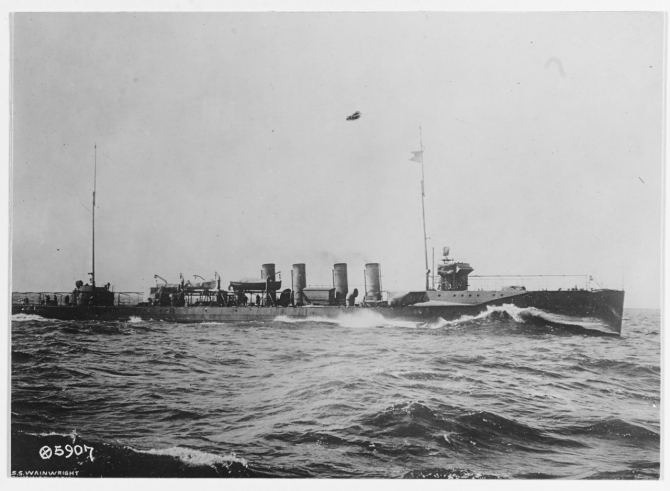
Wainwright photographed on preliminary trial standardization course, Delaware Breakwater. (Naval History and Heritage Command, NH 43769).
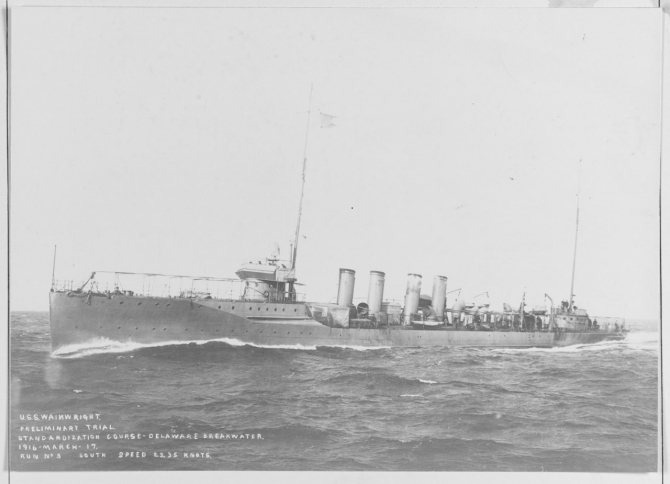
Wainwright steaming at 23.35 knots during preliminary trials on the Delaware Breakwater Standardization Course, 17 March 1916. Her guns and torpedo tubes have not yet been fitted. (Naval History and Heritage Command, NH 60565).
After fitting out and making trial trips at Philadelphia, the destroyer rounded Cape May, N.J. on 20 June 1916 and headed for Newport, R.I., to load torpedoes before joining Division 8 of the Atlantic Fleet Destroyer Flotilla. Following exercises near Eastport, Maine, she remained on the New England coast until mid-September when she headed south for gunnery tests and training off the Virginia capes. Upon the completion of a fortnight's gun drills, the ship then returned to Buzzard's Bay, Mass., on 2 October. Later that month, Wainwright operated out of Newport, practiced torpedo tactics near Vineyard Sound, and visited New York to pick up cargo for the flotilla's tender, Melville (Destroyer Tender No. 2). She returned to Newport on the 18th and, eight days later, resumed torpedo practice near Vineyard Sound for the remainder of the month. She put into Boston, Mass., on 1 November for extensive repairs in the navy yard.
Refurbished, the destroyer got underway for the Caribbean on 8 January 1917. Steaming via Hampton Roads, from whence she sailed on 11 January, she reached Culebra Island, near Puerto Rico, on the 14th and conducted war games and tactical exercises with the Atlantic Fleet. In the course of those operations, she visited the Dominican Republic as well as Guantanamo Bay and Santiago in Cuba. Later that month, Wainwright carried Assistant Secretary of the Navy Franklin D. Roosevelt, the Commandant of the Marine Corps, and the Chairman of the Civil Service Commission from Santiago to Port-au-Prince, Haiti. Following that assignment, she conducted torpedo exercises, patrols, and power trials near Guantanamo Bay until the beginning of March.
She returned to Boston on the 10th for a short period in the navy yard. On 31 March, she departed Boston for Hampton Roads where she arrived on 2 April. The following morning, in response to the imminent threat of war with Germany, Wainwright began to ". . . search for submarines . . ." and to patrol Hampton Roads to protect the Fleet and naval bases. Two days later, other warships relieved her on patrol; and she anchored with the fleet in the mouth of the York River. The next day, 6 April 1917, the United States declared war on Germany and entered World War I.
By the spring of 1917, the unrestricted submarine warfare campaign that Germany had launched at the beginning of February had succeeded to such an extent that it endangered the entire Allied war effort. Strong reinforcements to the Allied antisubmarine forces were urgently needed to avert defeat. As a result, the Royal Navy requested U.S. antisubmarine warfare ships in European waters. In response, the Navy planned to dispatch destroyers eastward across the Atlantic.
Wainwright again briefly patrolled Hampton Roads before heading for the New York Navy Yard on the 14th. From there, the destroyer continued on to Boston. Arriving on 16 April, she underwent preparations for overseas duty. Eight days later, the destroyer departed Boston in company with Wadsworth (Destroyer No. 60), Porter (Destroyer No. 59), Davis (Destroyer No. 65), Conyngham (Destroyer No. 58), and McDougal (Destroyer No. 54), bound for the British Isles. This division, led by Cmdr. Joseph K. Taussig, was the first American naval unit sent to European waters. The destroyers reached Queenstown on the southern coast of Ireland on 4 May and, after fueling, began patrolling the southern approaches to Liverpool and other British ports on the coast of the Irish Sea.
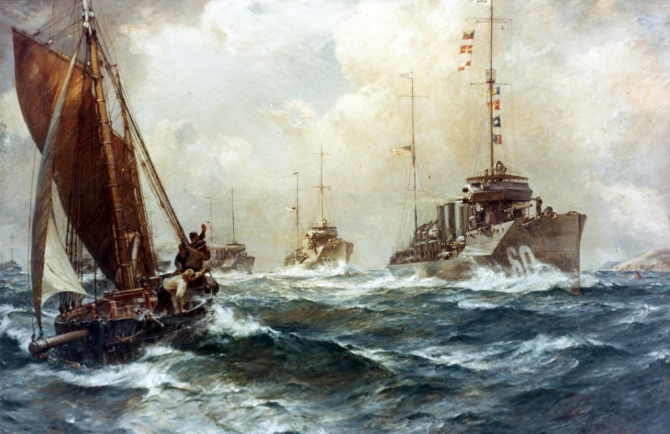
Return of the Mayflower, 4 May 1917. Oil on canvas by Bernard F. Gribble, circa 1918, depicting the arrival off Queenstown, Ireland, of the first U.S. Navy destroyers to reach the European war zone for World War I service. The ships were under the command of Cmdr. Joseph K. Taussig, USN. Wadsworth (Destroyer No. 60) leads the line of destroyers, followed by Porter (Destroyer No. 59), Davis (Destroyer No. 65), and three others. A local fishing vessel is under sail in the left foreground. Courtesy of the U.S. Naval Academy Museum, Annapolis, Md. USNA Museum Accession No. 21.9, gift of the Navy Department, 1921, Catalog #: KN-215.
Wainwright reported her first encounter with a German submarine on 11 May. She sighted an abandoned lifeboat around 0800. After investigating the drifting boat for occupants and finding none, she sank the boat with gunfire. About 15 minutes later, a lookout reported that a torpedo had missed the ship some 150 yards astern. Wainwright then fired several rounds from her 4-inch guns at what was thought to be a periscope. The supposed submarine disappeared soon thereafter; and, despite a thorough investigation of the area, the destroyer turned up no more evidence of a U-boat’s presence.
Summer 1917 provided few opportunities for Wainwright to test her sub-killing techniques. On 4 July, a member of the destroyer's crew spotted a purported periscope and soon thereafter others claimed that a torpedo was reported to have passed the ship, five feet astern. Wainwright depth-charged the last indicated position of the undersea raider, but to no avail. On 9 August, Wainwright, while escorting two oilers off Daunt Rock, witnessed the torpedo hit on the steamer S.S. Oakfield. Upon intercepting the ship’s S.O.S. call, the destroyer returned to provide assistance. Despite the damage, Oakfield did not sink and Wainwright escorted her into Queenstown.
Fall 1917, however, brought Wainwright increased activity. After spending the first two weeks of September in repairs at Birkenhead, near Liverpool, she departed the yard at Laird Basin around 0700 on the 14th to return to Queenstown. Three quarters of an hour into the afternoon watch, she received orders sending her to the scene of a submarine attack against an Allied merchantman some 15 miles south-southeast of Helvick Head, Ireland. Wainwright rang up full speed, made off for the reported location, and began a search for the U-boat in conjunction with a British dirigible and other surface units. At 1919, she sighted the submarine's conning tower and bow about six miles distant.
Wainwright charged to the attack, but the submarine submerged almost immediately. Upon reaching the spot where the submarine had been, the destroyer located an oil slick and began dropping depth charges which failed to achieve positive results. Approaching darkness and the necessity of escorting an Admiralty oiler, forced Wainwright to break off her attack. After she shepherded the oiler to safety, she returned to the area of her attack and patrolled throughout the night, but the submarine had apparently retired from the neighborhood. Four days later, while searching for a U-boat in the area of Connigbeh, the destroyer received word that the Connigbeh Lightship had rescued survivors from a fishing vessel. Wainwright rendezvoused with the craft to interview the four seamen of the smack Our Bairn. They revealed that the U-boat was of the latest type Germany had in action. The destroyer relieved the light vessel of the four fishermen and continued the search until dusk at 1740, when she headed back to Queenstown to land the rescued men, transferring them to the corvette HMS Colleen.
For a month, she carried on conducting routine patrols that brought no enemy action. The inhospitable Atlantic, however, severely taxed both ship and crew. Action finally came on the morning of 18 October 1917, when Wainwright again received orders to Helvick Head to hunt for an enemy submarine. She arrived at the designated location around 1115 and searched for more than two hours for clues as to the U-boat's location. Then, at 1358, she sighted a submarine's conning tower about 1,500 yards off her starboard bow. The enemy appeared to be maneuvering into position for a torpedo attack, but submerged the moment Wainwright charged to the attack. When the destroyer reached the estimated location of the U-boat, she dropped a depth charge and then a buoy to mark the spot. The warship followed that maneuver with a systematic, circular search out to a radius of 20 miles. Having found nothing by 0400 the following day, she gave up and set a course for Queenstown. In the morning on 20 October, after Rowan (Destroyer No. 64) brought up some oil with one of her depth charges, Wainwright dropped a couple of depth charges as she passed through the faint slick. A few minutes later, she joined other ships in some sporadic gunfire, but failed to prove that a submarine was in the area.
The ensuing six months brought no new encounters with U-boats. She scouted areas where submarines had been reported, but neither sighted nor engaged the enemy. On one occasion, she collided with a merchantman, SS Chicago City, and had to enter the drydock at Spencer Jetty that same day, 24 November 1917, for repairs. Another event of note was Wainwright’s escort, in company with O’Brien (Destroyer No. 51), of the transport Leviathan (SP-1326), the ex-Hamburg-Amerika liner Vaterland. Rendezvousing on 22 December, the destroyers accompanied the transport into the Mersey River anchorage at Liverpool on the 24th. Later that day, the destroyers took up the escort of the oiler SS Baku Standard from Liverpool to Queenstown. All arrived without incident on Boxing Day.
While steaming generally south on 29 April 1918, she sighted a sail bearing almost due west whose hull was down below the horizon. By the time the destroyer had swung around to an intercepting course, the sail had disappeared. While the destroyer steamed toward the estimated position of the sail, she searched for evidence of a submarine. After covering 10 miles to westward, she came upon an area marked by a number of small oil slicks. Wainwright chose the most promising of the slicks and dropped four depth charges. She then commenced another fruitless search which ended at midnight when she received orders to return to Queenstown.
Wainwright continued to operate out of Queenstown until June 1918, when she was reassigned to U.S. Naval Forces in France. On the 8th, she reported for duty at Brest, France, the port from which she conducted her patrols for the remainder of the war. Those patrols, however, brought no further encounters with the enemy. Only two events of note occurred between June and November 1918. On the night of 19-20 October, she sighted what appeared to be a submarine running on the surface. However, upon closer inspection, the object proved to be a derelict carrying the crew of the 77-ton Portuguese schooner Aida captured by a U-boat and sunk with explosive charges. Wainwright took on the seven survivors and saw them safely into port. Later, during the evening of 1 November, heavy winds at Brest caused the destroyer to drag anchor: and she struck the breakwater. After Jarvis (Destroyer No. 38) had failed to pull her loose, the tug Concord (No. 733) took over and finally managed to refloat the warship at 1920 and towed her into Brest.
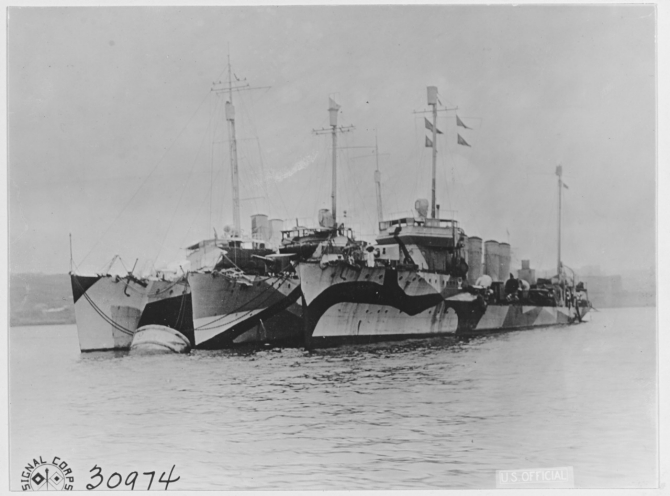
Wainwright, Winslow (Destroyer No. 53), and Bell (Destroyer No. 95) listed from right to left Moored to a buoy in the inner harbor of Brest, France on 27 October 1918. Note the various pattern camouflage designs worn by these three ships. (U.S. Army Signal Corps Photograph, Naval History and Heritage Command, NH 41513).
With the Armistice, hostilities ended on 11 November 1918. Wainwright, in company with Porter, Cushing (Destroyer No. 55), Benham (Destroyer No. 49), Ericsson (Destroyer No. 56), O’Brien, and Fairfax (Destroyer No. 93), stood out of Brest on 21 December and steamed for Boston via the Azores. Arriving on 8 January 1919, she resumed her duty with the Atlantic Fleet destroyers steaming for the drill grounds off Guantanamo Bay for exercises and returning to New York on 14 April. Leaving New York bound for the Azores on 1 May, she departed Ponta del Gada for a return to Boston on 29 May. Shortly thereafter, she was transferred to the Philadelphia Navy Yard on 13 July and placed in reserve there on the 23rd.
Operating from Philadelphia, on 21 March 1921, Wainwright cruised along the Eastern seaboard making visits to Charleston, S.C., New York, and Newport, R.I. and was eventually placed out of commission at Philadelphia on 19 May 1922.
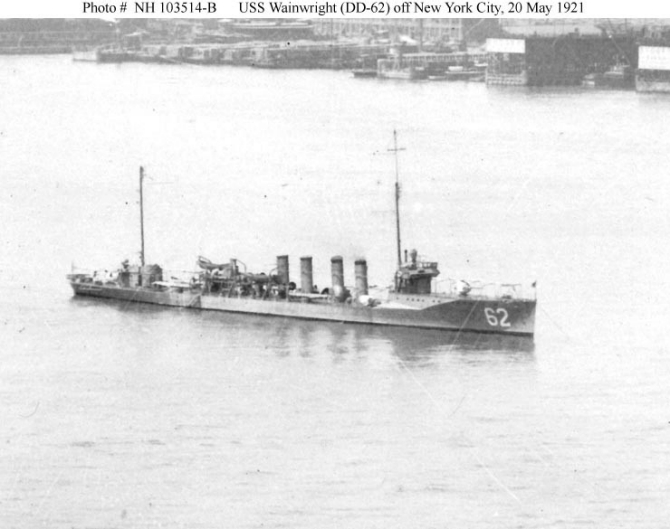
Wainwright in the North River off New York City, 20 May 1921. Cropped from NH 103514, a panoramic photograph by Himmel and Tyner, New York. (Naval History and Heritage Command, NH 103514-B).
Wainwright remained in reserve until spring 1926. On 2 April, her name was stricken from the Navy list and she was transferred to the Treasury Department for service with the U.S. Coast Guard. Re-designated CG-24, the destroyer retained her name. Assigned to service with the Coast Guard’s Destroyer Force, she was to interdict the illegal importation of alcohol in the enforcement of the 18th Amendment (Prohibition). Capable of well over 25 knots, seemingly an advantage in the interdicting of rumrunners, she was easily outmaneuvered by smaller vessels. As a result, the destroyer picketed the larger supply ships ("mother ships") on Rum Row and in order to prevent them from off-loading their illicit cargo onto the smaller, speedier contact boats that ran the liquor into shore.
She moved to Boston on 22 May 1922 and remained there until 27 July when she got underway for New London, Conn., her homeport as a unit in Division 3. She reached her destination two days later; and on 30 May, she was commissioned in the Coast Guard, Cmdr. John J. Hutson, USCG, in command. She served at New London from the summer into 1929. On 4 January 1929, she headed south to Charleston, S.C., whence she conducted gunnery practice until 4 February. During the competitions for Gunnery Year 1928-1929, Wainwright rated dead last of the 24 destroyers that competed. Standing 18th in the Short-Range Battle Practice, her position as the worst shooting unit in the Destroyer Force was ensured by her last-place score in the Long-Range Battle Practice. Afterward, she steamed north to her new homeport at Boston.
In January 1930, she headed south again for gunnery practice. This time firing at St. Petersburg, Fla., under Gunnery Officer, Ens. Stanley F. Piekos, she gave a much better account of herself. Rating only ninth in the Short-Range Battle Practice, Wainwright improved to fifth in the Long-Range Battle Practice to place sixth in the order of merit of the 19 destroyers that fired. During each of the two succeeding years, in January 1931 and late in March 1932, she returned to St. Petersburg for a month of target practice. In 1931 she stood eighth among the 13 participants and in 1932, her standing again dropped to the bottom of the table of the 13 competitors in the Destroyer Force. In both years, after the gunnery competitions she returned north and resumed her duties along the New England coast.
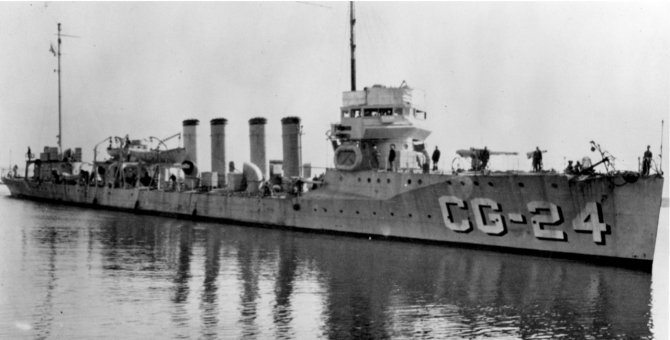
Wainwright, designated CG-24, during her service with the Coast Guard enforcing the 18th Amendment (Prohibition), date unknown. (U.S. Coast Guard Historian’s Office).
Wainwright’s permanent duty station changed on 22 May 1933 to New York and service with Division 4. She reported to the station at Stapleton (Staten Island), N.Y. on 7 June. After a summer of normal operations, the destroyer began target practice at Hampton Roads on 7 September. That assignment, however, was interrupted that same day when she received orders to proceed to Key West, Fla. She arrived on the 9th and reported for duty with the Navy. Wainwright’s mission was to operate in the Florida Strait and around Cuba during the series of revolts then gripping the island. The destroyer called at Matanzas, Cuba on 2 October and later shifted to Havana until receiving orders to return to the U.S. Departing on 27 October, she arrived at Key West later that day. Wainwright was detached from duty with the Navy on 6 November and received orders to return to New York. She reached three days later and resumed operations patrolling the Eastern Area.
Wainwright departed Stapleton on 14 March 1934, and arrived at the Philadelphia Navy Yard, the following day. She was decommissioned by the Coast Guard on 29 March; and, on 27 April, the Commandant, 4th Naval District, took possession of her for the Navy.
Wainwright was briefly reinstated on the Navy list, but was stricken once again on 5 July 1934. She was sold to Michael Flynn, Inc., of Brooklyn, N.Y., on 22 August, for scrapping in accordance with the London Treaty limiting naval armament.
Commanding Officers Dates of Command
Lt. Fred H. Poteet |
12 May 1916 – 26 December 1917 |
Lt. Cmdr. Robert A. Dawes |
26 December 1917 – 7 July 1918 |
Lt. Cmdr. Emory F. Clement |
7 July 1918 – 10 July 1919 |
Lt. Maxwell Cole |
10 July 1919 – 2 December 1919 |
Lt. (j.g.) Frederick A. Hardesty |
2 December 1919 – 2 February 1920 |
Lt. Elmer J. Tiernan |
2 February 1920 – 11 August 1921 |
Lt. (j.g.) James L. Holloway Jr. |
11 August 1921 – 6 December 1921 |
Lt. William L. Wright |
6 December 1921 – 19 May 1922 |
Cmdr. John J. Hutson, USCG |
31 May 1926 – 1 November 1927 |
Cmdr. James Pine, USCG |
1 November 1927 - 29 April 1930 |
Lt. Cmdr. Carl H. Abel, USCG |
29 April 1930 – 24 February 1931 |
Lt. Cmdr. Henry Coyle, USCG |
24 February 1931 – 11 July 1932 |
Lt. Cmdr. Robert C. Jewell, USCG |
11 July 1932 – 15 June 1933 |
Lt. Cmdr. Rae B. Hall, USCG |
15 June 1933 – 29 March 1934 |
Christopher B. Havern Sr. 14 December 2017


